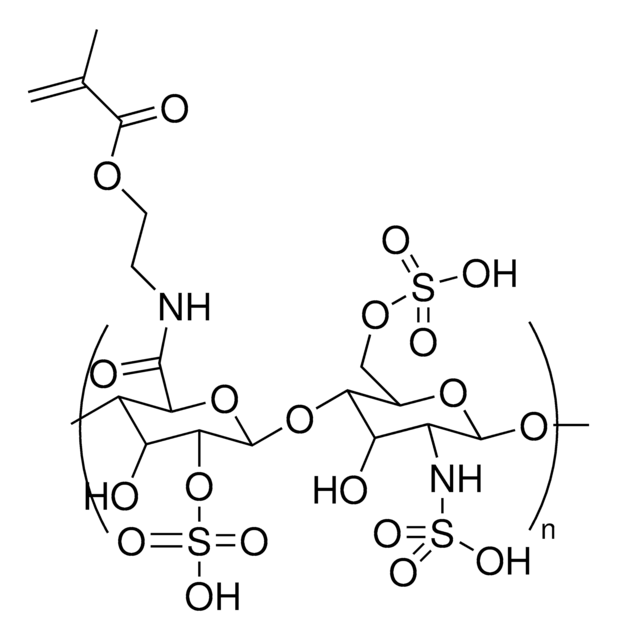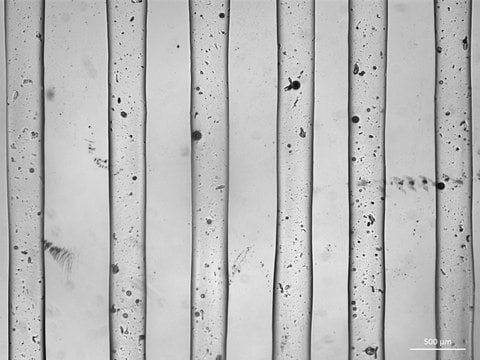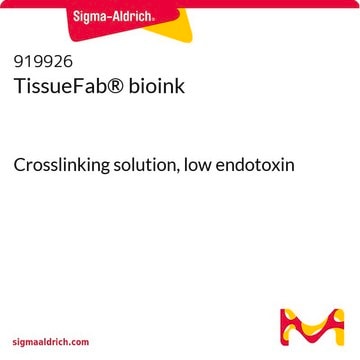934178
TissueFab® bioink
(GelHAHep)MA Vis/405 nm, low endotoxin
Sinonimo/i:
3D Bioprinting, Bioink, Controlled Release, GelMA, Gelatin, Gelatin Methacryloyl, HAMA, Heparin, Heparin Methacrylate, Hyaluronan, Hyaluronic Acid, Hyaluronic Acid Methacrylate, Hydrogel
About This Item
Prodotti consigliati
Livello qualitativo
Sterilità
0.2 μm filtered
Stato
gel form
contiene
<50 EU/mL Endotoxin
Composizione
Gelatin, Hyaluronic acid, Heparin, Alginate
Impurezze
<5 CFU/g Bioburden ( fungal)
<5 CFU/g Bioburden (Total Aerobic)
Colore
pale yellow to colorless
pH
6.5-7.5
Compatibilità
3D bioprinting, extrusion bioprinting
Temperatura di conservazione
2-8°C
Cerchi prodotti simili? Visita Guida al confronto tra prodotti
Categorie correlate
Descrizione generale
Applicazioni
- drug discovery
- in-vitro disease models
- regenerative medicine-cell-cultured meat
Caratteristiche e vantaggi
- Bioprinting models replicate biology for drug discovery and in vivo applications
- Sterile, low endotoxin-Batch control offers reproducible models for preclinical toxicology testing and drug screening
- Extended shelf-life & stability
Altre note
The methacrylate-functionalization of heparin allows thermal or photochemical crosslinking via covalent conjugation. Heparins exhibit high anionic charge densities to promote large swelling ratios in water. Heparin-based bioinks are used in tissue engineering, 3D bio-printing, and drug delivery applications.
Gelatin methacryloyl (GelMA) is a polymerizable hydrogel material derived from natural extracellular matrix (ECM) components. Due to its low cost, abundance, and retention of natural cell binding motifs, gelatin has become a highly sought material for tissue engineering applications. The addition of photocrosslinkable methacrylamide functional groups in GelMA allows the synthesis of biocompatible, biodegradable, and non-immunogenic hydrogels that are stable in biologically relevant conditions and promote cell adhesion, spreading, and proliferation.
Hyaluronic acid (HA) is a linear polysaccharide of alternating D-glucuronic acid/N-acetyl-D-glucosamine found primarily in connective tissues. HA-based hydrogels are prevalent in tissue engineering, 3D bioprinting, and drug delivery applications. The methacrylate (MA) functionalized hyaluronic acid is photo-cross-linkable.
Low Endotoxin, low bioburden: Endotoxins can negatively impact cellular growth, morphology, differentiation, inflammation, and protein expression. The bioburden is the number of contaminated organisms found in a given amount of material.
We test each lot for endotoxins in addition to total bioburden (aerobic and fungal) to minimize unwanted interactions. For more information: Cell Culture FAQs: Bacterial Endotoxin Contamination
Note legali
Codice della classe di stoccaggio
12 - Non Combustible Liquids
Classe di pericolosità dell'acqua (WGK)
WGK 3
Punto d’infiammabilità (°F)
Not applicable
Punto d’infiammabilità (°C)
Not applicable
Scegli una delle versioni più recenti:
Certificati d'analisi (COA)
It looks like we've run into a problem, but you can still download Certificates of Analysis from our Documenti section.
Se ti serve aiuto, non esitare a contattarci Servizio Clienti
Possiedi già questo prodotto?
I documenti relativi ai prodotti acquistati recentemente sono disponibili nell’Archivio dei documenti.
Active Filters
Il team dei nostri ricercatori vanta grande esperienza in tutte le aree della ricerca quali Life Science, scienza dei materiali, sintesi chimica, cromatografia, discipline analitiche, ecc..
Contatta l'Assistenza Tecnica.








